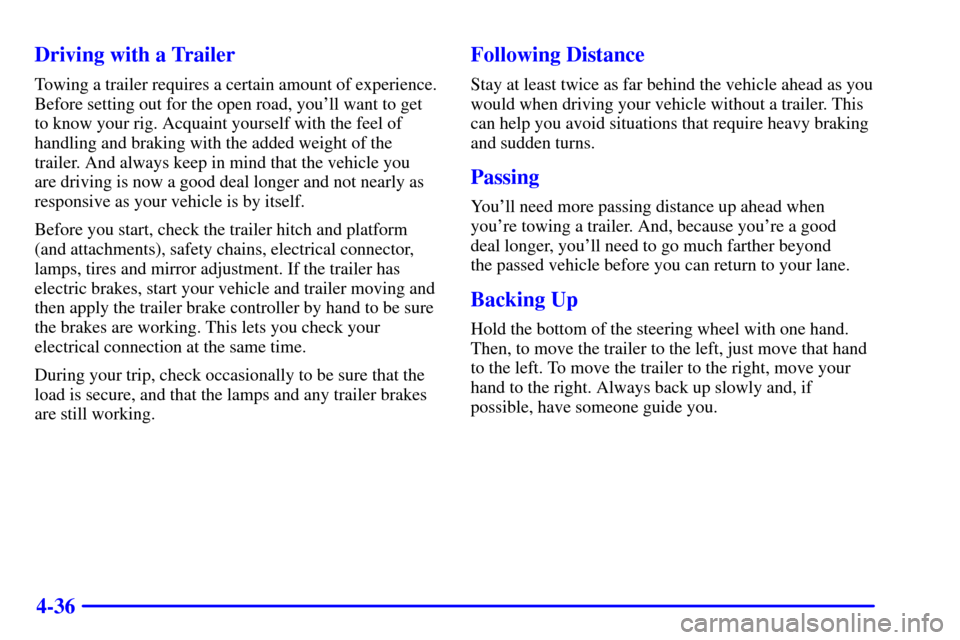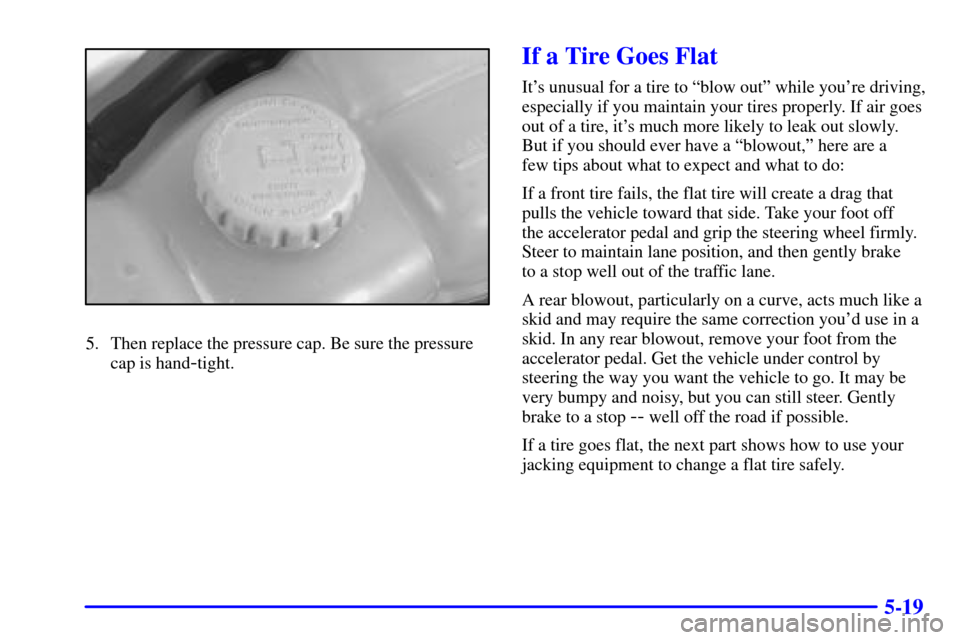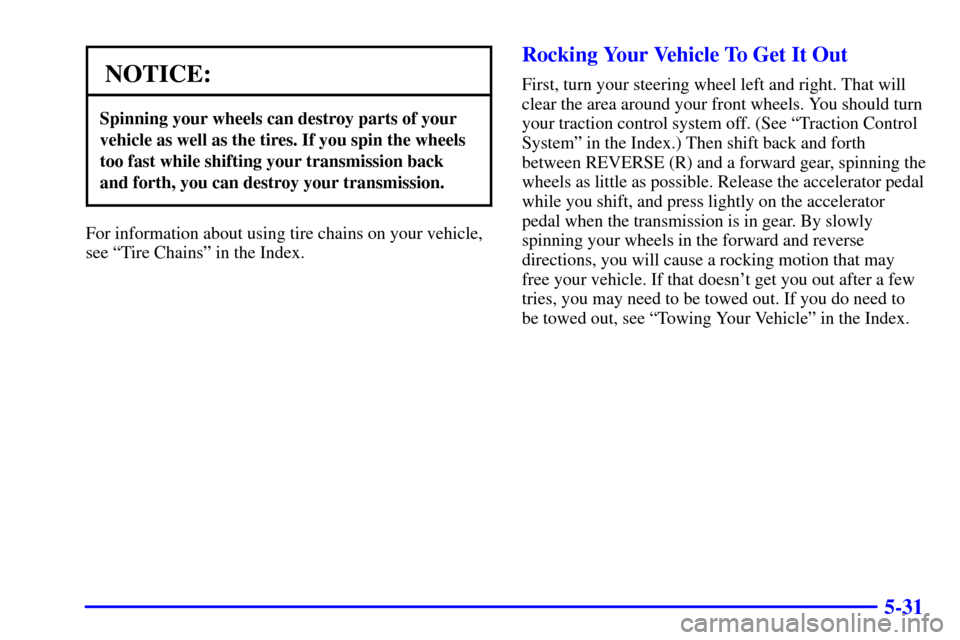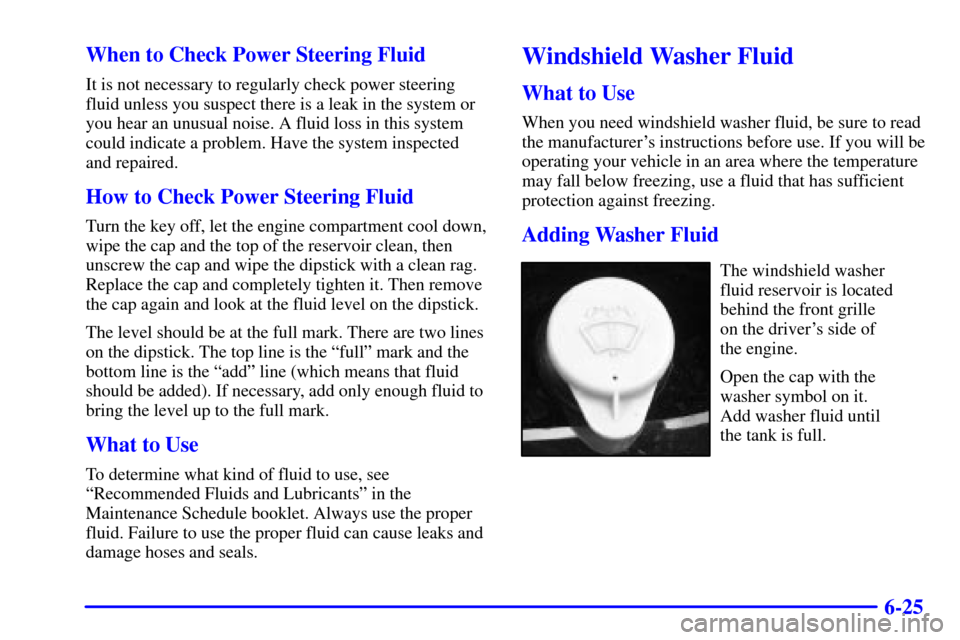Page 211 of 321

4-36 Driving with a Trailer
Towing a trailer requires a certain amount of experience.
Before setting out for the open road, you'll want to get
to know your rig. Acquaint yourself with the feel of
handling and braking with the added weight of the
trailer. And always keep in mind that the vehicle you
are driving is now a good deal longer and not nearly as
responsive as your vehicle is by itself.
Before you start, check the trailer hitch and platform
(and attachments), safety chains, electrical connector,
lamps, tires and mirror adjustment. If the trailer has
electric brakes, start your vehicle and trailer moving and
then apply the trailer brake controller by hand to be sure
the brakes are working. This lets you check your
electrical connection at the same time.
During your trip, check occasionally to be sure that the
load is secure, and that the lamps and any trailer brakes
are still working.
Following Distance
Stay at least twice as far behind the vehicle ahead as you
would when driving your vehicle without a trailer. This
can help you avoid situations that require heavy braking
and sudden turns.
Passing
You'll need more passing distance up ahead when
you're towing a trailer. And, because you're a good
deal longer, you'll need to go much farther beyond
the passed vehicle before you can return to your lane.
Backing Up
Hold the bottom of the steering wheel with one hand.
Then, to move the trailer to the left, just move that hand
to the left. To move the trailer to the right, move your
hand to the right. Always back up slowly and, if
possible, have someone guide you.
Page 232 of 321

5-19
5. Then replace the pressure cap. Be sure the pressure
cap is hand
-tight.
If a Tire Goes Flat
It's unusual for a tire to ªblow outº while you're driving,
especially if you maintain your tires properly. If air goes
out of a tire, it's much more likely to leak out slowly.
But if you should ever have a ªblowout,º here are a
few tips about what to expect and what to do:
If a front tire fails, the flat tire will create a drag that
pulls the vehicle toward that side. Take your foot off
the accelerator pedal and grip the steering wheel firmly.
Steer to maintain lane position, and then gently brake
to a stop well out of the traffic lane.
A rear blowout, particularly on a curve, acts much like a
skid and may require the same correction you'd use in a
skid. In any rear blowout, remove your foot from the
accelerator pedal. Get the vehicle under control by
steering the way you want the vehicle to go. It may be
very bumpy and noisy, but you can still steer. Gently
brake to a stop
-- well off the road if possible.
If a tire goes flat, the next part shows how to use your
jacking equipment to change a flat tire safely.
Page 244 of 321

5-31
NOTICE:
Spinning your wheels can destroy parts of your
vehicle as well as the tires. If you spin the wheels
too fast while shifting your transmission back
and forth, you can destroy your transmission.
For information about using tire chains on your vehicle,
see ªTire Chainsº in the Index.
Rocking Your Vehicle To Get It Out
First, turn your steering wheel left and right. That will
clear the area around your front wheels. You should turn
your traction control system off. (See ªTraction Control
Systemº in the Index.) Then shift back and forth
between REVERSE (R) and a forward gear, spinning the
wheels as little as possible. Release the accelerator pedal
while you shift, and press lightly on the accelerator
pedal when the transmission is in gear. By slowly
spinning your wheels in the forward and reverse
directions, you will cause a rocking motion that may
free your vehicle. If that doesn't get you out after a few
tries, you may need to be towed out. If you do need to
be towed out, see ªTowing Your Vehicleº in the Index.
Page 245 of 321

6-
6-1
Section 6 Service and Appearance Care
Here you will find information about the care of your vehicle. This section begins with service and fuel information,
and then it shows how to check important fluid and lubricant levels. There is also technical information about your
vehicle, and a part devoted to its appearance care.
6
- 2 Service
6
- 3 Fuel
6
- 5 Fuels in Foreign Countries
6
- 5 Filling Your Tank
6
- 9 Checking Things Under the Hood
6
- 11 Engine Oil
6
- 15 Engine Air Cleaner/Filter
6
- 19 Automatic Transmission Fluid
6
- 19 Rear Axle
6
- 20 Engine Coolant
6
- 24 Surge Tank Pressure Cap
6
- 24 Power Steering Fluid
6
- 25 Windshield Washer Fluid
6
- 26 Brakes
6
- 30 Battery
6
- 30 Bulb Replacement6
- 37 Wiper Blade Replacement
6
- 38 Tires
6
- 47 Appearance Care
6
- 47 Cleaning the Inside of Your Vehicle
6
- 49 Care of Safety Belts
6
- 51 Cleaning the Outside of Your Vehicle
6
- 52 Cleaning Aluminum or Chrome-Plated
Wheels (If Equipped)
6
- 53 Underbody Maintenance
6
- 54 GM Vehicle Care/Appearance Materials
6
- 55 Vehicle Identification Number (VIN)
6
- 55 Service Parts Identification Label
6
- 56 Electrical System
6
- 63 Replacement Bulbs
6
- 63 Capacities and Specifications
6
- 64 Normal Maintenance Replacement Parts
Page 254 of 321
6-10
When you open the hood, you'll see:
A. Coolant Fill Location
B. Engine Air Cleaner/Filter
C. Passenger Compartment
Air FilterD. Engine Oil Fill Location
E. Engine Oil Dipstick Location
F. Windshield Washer FluidG. Brake Master Cylinder
H. Power Steering Fluid
I. Battery
Before closing the hood, be sure all filler caps are on properly. Then pull the hood down and close it firmly.
Page 268 of 321
6-24
Surge Tank Pressure Cap
NOTICE:
The surge tank cap is a 14 psi (97 kPa)
pressure
-type cap and must be tightly installed
to prevent coolant loss and possible engine
damage from overheating.
Power Steering Fluid
The power steering fluid reservoir is located between
the battery and the brake master cylinder on the driver's
side of the engine.
Page 269 of 321

6-25 When to Check Power Steering Fluid
It is not necessary to regularly check power steering
fluid unless you suspect there is a leak in the system or
you hear an unusual noise. A fluid loss in this system
could indicate a problem. Have the system inspected
and repaired.
How to Check Power Steering Fluid
Turn the key off, let the engine compartment cool down,
wipe the cap and the top of the reservoir clean, then
unscrew the cap and wipe the dipstick with a clean rag.
Replace the cap and completely tighten it. Then remove
the cap again and look at the fluid level on the dipstick.
The level should be at the full mark. There are two lines
on the dipstick. The top line is the ªfullº mark and the
bottom line is the ªaddº line (which means that fluid
should be added). If necessary, add only enough fluid to
bring the level up to the full mark.
What to Use
To determine what kind of fluid to use, see
ªRecommended Fluids and Lubricantsº in the
Maintenance Schedule booklet. Always use the proper
fluid. Failure to use the proper fluid can cause leaks and
damage hoses and seals.
Windshield Washer Fluid
What to Use
When you need windshield washer fluid, be sure to read
the manufacturer's instructions before use. If you will be
operating your vehicle in an area where the temperature
may fall below freezing, use a fluid that has sufficient
protection against freezing.
Adding Washer Fluid
The windshield washer
fluid reservoir is located
behind the front grille
on the driver's side of
the engine.
Open the cap with the
washer symbol on it.
Add washer fluid until
the tank is full.
Page 302 of 321
6-58
Instrument Panel Fuse Block (Driver's Side)
The fuse block is located below the steering wheel on
the driver's side. Using a screwdriver, loosen the two
trim fasteners under the trim panel and pull the trim
panel away from the instrument panel to access.
Fuse Usage
1 RH and LH Front Side Door Window
Regulator Motor, LH Front Side Door
Window Switch
2 Stoplamp Switch, Cruise Control
Release Switch
3 Automatic Transmission Range Switch,
Automatic Transmission Control Indicator,
Power Steering Control Module, Hazard
Warning Switch, Automatic Transmission
Winter Mode Switch, Transmission
Control Module (TCM)